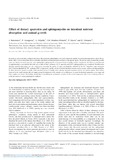Mostrar el registro sencillo del ítem
Effect of dietary quercetin and sphingomyelin on intestinal nutrient absorption and animal growth
| dc.creator | Barrenetxe, Jaione | es_ES |
| dc.creator | Aranguren Garacochea, Patricia | es_ES |
| dc.creator | Grijalba, A. | es_ES |
| dc.creator | Martínez-Peñuela, J. M. | es_ES |
| dc.creator | Marzo Pérez, Florencio | es_ES |
| dc.creator | Urdaneta, Elena | es_ES |
| dc.date.accessioned | 2019-01-16T08:07:55Z | |
| dc.date.available | 2019-01-16T08:07:55Z | |
| dc.date.issued | 2006 | |
| dc.identifier.issn | 0007-1145 (Print) | |
| dc.identifier.issn | 1475-2662 (Electronic) | |
| dc.identifier.uri | https://hdl.handle.net/2454/31971 | |
| dc.description.abstract | Research on cancer and other conditions has shown flavonoids and sphingolipids to be food components capable of exerting chemoprotective action. Nevertheless, little is known about their effects on healthy individuals and their potential usefulness as therapeutic agents. The present study examined the possible action of a dietary flavonoid, quercetin, and a sphingolipid, sphingomyelin, as functional foods in healthy animals. In particular, the effect on animal growth of supplementing a conventional diet with one or other of these substances (0·5% quercetin and 0·05% sphingomyelin) was considered. Possible action affecting intestinal physiology was also analysed by measuring the uptake of sugar and dipeptide, mediated by the Na+-dependent sugar transporter SGLT1 and the dipeptide Na+/H+ exchanger PEPT1 respectively, and the activity of related intestinal enzymes such as sucrase, maltase and aminopeptidase N. Both substances seemed to modify small intestinal activity in healthy mice, altering intestinal enzymatic activity and nutrient uptake. These effects observed in the small intestine did not impair normal development of the animals, as no differences in serum biochemical parameters or in organ and body weights were found. The findings should help in elucidating the mechanisms of action of these food components with a view to their possible use in the prevention of certain pathological conditions. | en |
| dc.format.extent | 7 p. | |
| dc.format.mimetype | application/pdf | en |
| dc.language.iso | eng | en |
| dc.publisher | Cambridge University Press | en |
| dc.relation.ispartof | British Journal of Nutrition (2006), 95, 455–46 | en |
| dc.rights | © The Authors 2006 | en |
| dc.subject | Quercetin | en |
| dc.subject | Sphingomyelin | en |
| dc.subject | Nutrient absorption | en |
| dc.subject | Animal growth | en |
| dc.title | Effect of dietary quercetin and sphingomyelin on intestinal nutrient absorption and animal growth | en |
| dc.type | info:eu-repo/semantics/article | en |
| dc.type | Artículo / Artikulua | es |
| dc.contributor.department | Ciencias del Medio Natural | es_ES |
| dc.contributor.department | Natura Ingurunearen Zientziak | eu |
| dc.rights.accessRights | info:eu-repo/semantics/openAccess | en |
| dc.rights.accessRights | Acceso abierto / Sarbide irekia | es |
| dc.identifier.doi | 10.1079/bjn20051651 | |
| dc.relation.publisherversion | https://doi.org/10.1079/bjn20051651 | |
| dc.type.version | info:eu-repo/semantics/publishedVersion | en |
| dc.type.version | Versión publicada / Argitaratu den bertsioa | es |


